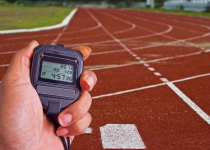7 Strategies for Running a Faster Mile

By Samantha Lefave, Runner's World
One. Single. Mile. For many, the distance is equally attainable and intimidating. When motivation is waning, it’s common to tell yourself “just do one Mile” to get going. But when it’s time to race that Mile? Well, that’s a different beast.
“The Mile will take you to your threshold nearly the entire time,” says Ashley Paulson, certified iFit trainer and run coach. “You’ll feel your lungs burn and the blood in your legs pulsing.” But that doesn’t (and shouldn’t) stop us from trying to get faster at the classic distance. “As runners, we are always pushing our own boundaries,” Paulson says. “The Mile is a great way to check your cardiovascular fitness, it’s a good tool to predict other race times, and it can serve as a baseline for programming other running workouts.”
So, to test your skills and have your best performance come race day, steal these tips on how to run a faster Mile.
1) Know Where You're Starting
“How can you know where you’re going if you don’t know where you are?” Paulson says. “Watching yourself improve is the biggest motivator.” That’s why she recommends doing a time trial before you actually begin training to run a faster Mile.
You don’t have to wait for an organized event to establish your starting point. Yes, there are benefits to doing so—a mapped-out and timed course, plus the adrenaline and energy from the crowd—but there are also variables outside of your control at races.
When doing your own time trial, Paulson says, you can pick how soon you test, where you do it, and which weather conditions you’ll run in. (Feel free to skip a rainy day.) Paulson recommends doing your trial run four to six weeks prior to “game day” to give your body enough time to build up the power and endurance you’ll need to cross the finish line faster.
2) Kick Up Your Cadence
“Most new runners have a stride turnover that’s too slow,” Paulson says. But learning how to take quicker, shorter steps can help improve your pace, she adds. (Research shows it may also minimize your chances of injury.)
Your ideal cadence is personal—Paulson aims for 180 to 190 steps per minute. In general, though, research suggests that a 10 percent increase from wherever you’re at now can help reduce the impact on knees and hips, lowering the risk of aches and pains. If you don’t have a watch that determines your cadence, you can easily count how many times your foot hits the ground while running for one minute—double that to account for both feet—a test Paulson suggests doing once a week.
If you need to quicken your steps, Paulson suggests using a metronome app. You can set it to your ideal cadence and it’ll ping every time your foot should contact the ground. It’s also smart to search for songs featuring the beats per minute (BPM) you want to step to and create a playlist from those songs so you can run to the music. (You can also search Spotify for specific BPM playlists.) Another option: Hop on a treadmill, as experts have found treadmill runners typically have a higher stride rate when compared with those who run outdoors.
3) Home in on Hills
Every speedy runner will tell you hill workouts can make or break your PR attempt. Regularly adding them to your training plan can improve your running efficiency and raise your lactate threshold (the intensity at which your body produces more lactic acid than it can remove, causing fatigue) and therefore quicken your Mile time, Paulson says.
Research from South Dakota deems them worth it, too: After six weeks of hill workouts twice a week, runners increased their top speed—and held that faster pace for 32 percent longer. It’s best to incorporate hard hill workouts every other week as part of speed training, Paulson says.
An example workout: After your warmup, set your incline to 5 percent and run for one minute at goal pace. Then, recover for one minute, stepping off the belt. Repeat for three sets, slowly building to five or six sets throughout training. Walk or jog for five to 10 minutes to cool down.
Also, aim for significant inclines. In the study mentioned above, runners set their treadmills to a 10 percent incline—a fairly steep grade.
4) Take on Tabatas
Interval workouts are known for improving speed, potentially increasing your VO2 max (how much oxygen your body can use during exercise) and lowering your resting heart rate. They’re ideal because the working periods are just long enough to stress both your aerobic and anaerobic systems—both of which are used during a Mile race—without putting you at risk of injury or overwork, says Danny Mackey, head coach of Brooks Beast track club.
Try this treadmill Tabata once a week: After a warmup, set your incline to 1 or 2 percent. Run at 10 percent above your Mile goal pace for 20 seconds, then recover for 10 seconds. Repeat for eight total rounds (that’s four minutes). If you feel like you have more left in the tank after completing the above set, do another, Paulson says. Just take a two-minute recovery walk before beginning your next four-minute set. Then wrap up with a five- to 10-minute cooldown.
Continue reading at: runnersworld.com
